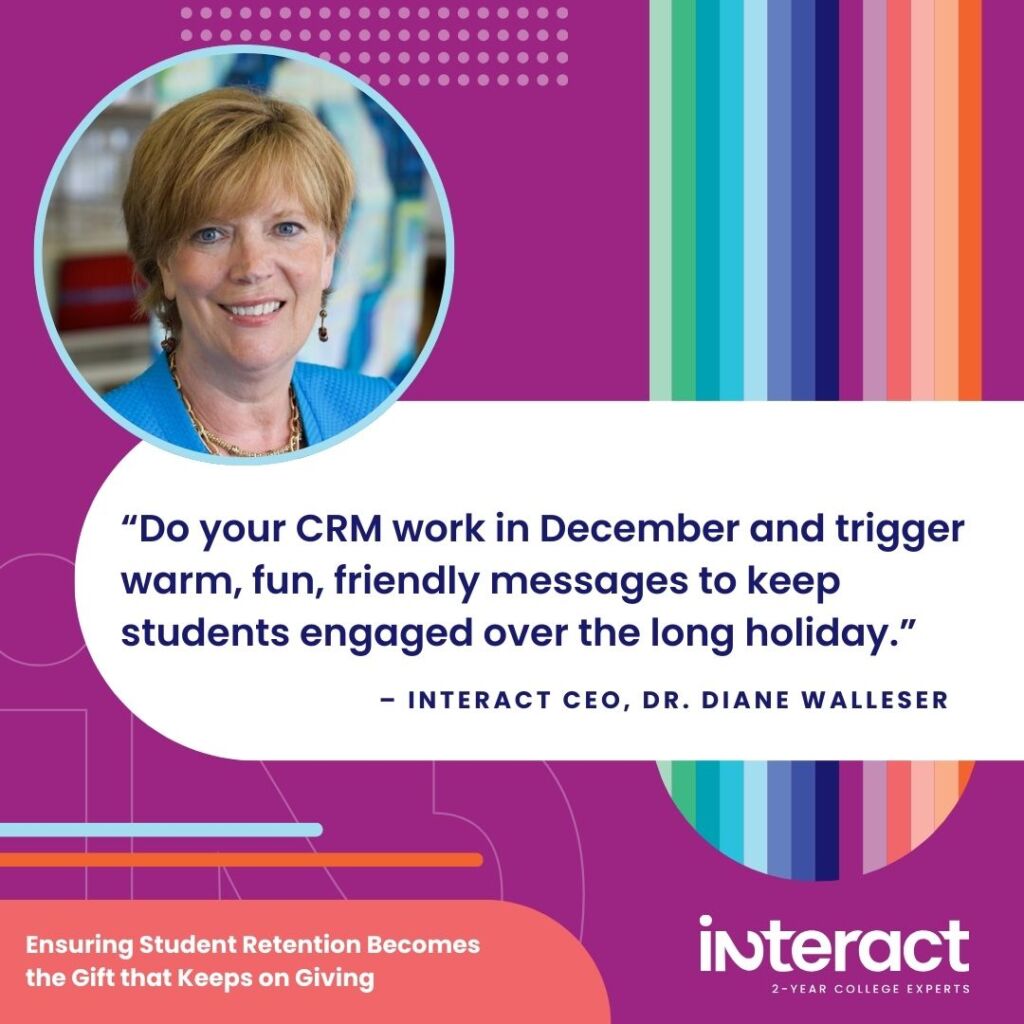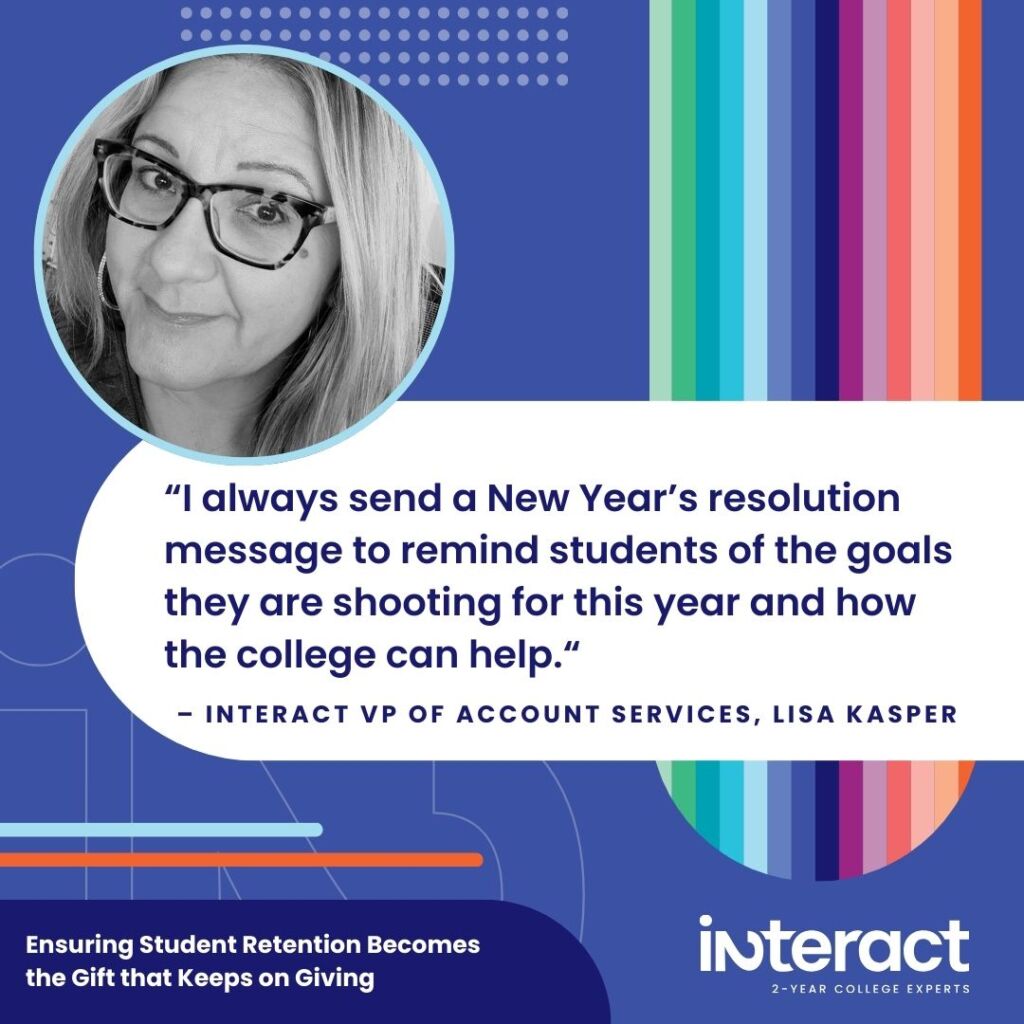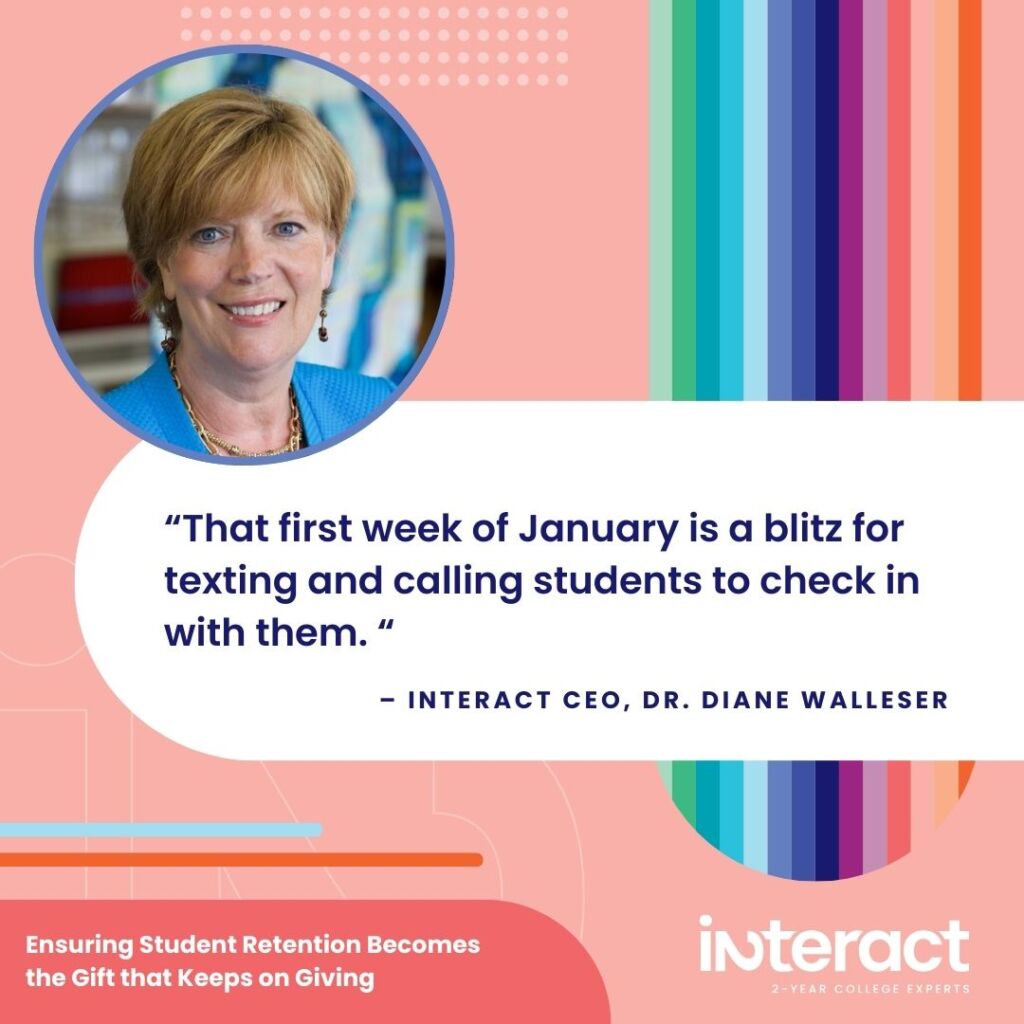Student retention might be our greatest gift this December, especially as traditional student numbers decline due to the enrollment cliff. Whether it’s before, during, or after the winter break, here are our experts’ strategies to retain students this spring semester and beyond.
“What’s tough about admissions is that people are trying to get their numbers up with new students or transfers in January, and they’re not thinking about the existing students returning,” says our CEO, Dr. Diane Walleser. “Yet, it’s essential for enrollment health and student success to prioritize our retention efforts.”

Continue reading for our team’s top student retention tips to help keep learners in seats.
An Ounce of Prevention is Worth a Pound of Student Retention
What to Do Before the Winter Break
Connecting with students to make sure they’ve registered for classes before they leave for break is crucial. As Walleser says, “There is a huge student retention drop-off from the holiday break to January.”
We know from Interact’s internal research that holiday breaks are when colleges typically churn out the most students:

So, what can you do if your students are slow to register for the next semester?
“Before the break is a great time to get faculty involved to do some outreach,” says our VP of Account Services, Lisa Kasper. Giving faculty members prepared messages and cues for timed texts, emails, and learning management nudges is key.

“The greatest advocates for your college are really your instructors,” adds our Chief Marketing and Growth Officer, Chelsey Bowers. “They’re by far the greatest resource your college has for retention.”
During the Winter Break: Don’t Break Your Connection for Student Retention
We need to make every student count in our enrollment and retention efforts, so we can’t afford to “go dark.” Keep your college top of mind over the break with some friendly student retention outreach. If you have a good CRM system, it’s a cinch to schedule triggered communications.
“Do your CRM work in December and trigger warm, fun, friendly messages to keep students engaged over the long holiday,” advises Walleser.

Are you worried about bothering learners? Don’t be. If you’re not nudging students daily, and the message is at a natural point in the communication process, then reach out.
“If it’s a warm and friendly message, they are not going to complain,” says our CEO. “Little things that say ‘We miss you’ or ‘We can’t wait to see you in the spring semester’ help keep up that personal connection.”
Since students might be checked out from their emails over the break, texting is a good way to check in.
“We have heard, time and time again, that texting is really effective,” says Kasper. And if you’re looking for ideas, our VP has a shoo-in: “I always send a New Year’s resolution message to remind students of the goals they are shooting for this year and how the college can help.”

A good practice is separating your contacts into students who have already registered and those who haven’t. That way, you can make different messaging tracks for each group … and remind students who haven’t signed up yet that registering is the best way to meet their New Year’s resolutions.
Gear Up for the First Week of January “Blitz”
Since many schools don’t resume until the middle or end of January, the beginning of the new year is a great time to touch base.
“That first week of January is a blitz for texting and calling students to check in with them,” says Walleser.

Connect with students who haven’t registered yet and offer extra help. You can also target students who have only signed up to be part-time.
“Maybe they’re a full-time student who normally takes four classes, but they’re only registered for two,” says Walleser. Those students might just need one more nudge to top off their schedule. “It can be extremely beneficial to do a credit encouragement campaign in the first part of January.”
We know that students are more successful when they attend full time. Plus, full-time students can help you reach your enrollment goals more quickly.
[When colleges already struggle to attract and retain students, how can we encourage full-time enrollment? Read more in our blog, “Transforming Education in Community Colleges: Navigating the Winds of Change”]
January Is Also the Time to Target Stop-Outs
On top of redoubling your student retention efforts, January is the perfect time to reconnect with stop-outs.
“As an admissions director, whether I was at a four-year or two-year school, I really capitalized on messaging my past applicants and students that didn’t return to campus,” says Kasper. “In a perfect world, it’s better to go after those stop-outs earlier. But in reality, most community colleges go after them in January.”

And how you reach out to stop-out students is just as important as when.
“The phone isn’t dead, and I don’t mean that just for texting,” says Bowers. She recommends trying enrollment campaigns that call your stop-outs. “When you talk to them on the phone, they’re blown away that somebody is actually making a personal connection with them. And sometimes, that’s the difference between holding on to them and losing them.
“We have to show students how much we care.”

Student Retention Health Checks: Doubling Down on Data for Real-World Results
Once the spring semester is underway, it pays to pause and take stock. Look at your data and investigate how many students were lost between semesters. Pay special attention to how many students tried to register but abandoned the process.

“You know that the intent was there,” says Kasper. “So, you have to start looking inward to see if something thwarted their efforts and if it was an issue with the college’s processes.”
Using Data to Predict Student Success
You can go even deeper into your data to enrich student retention efforts by identifying predictors of student success.
“Look at the last five or 10 years of your student data and identify the characteristics, triggers, and milestones that sparked success and got them to graduation,” advises Walleser. Those milestones might be advising, orientation, continuous enrollment, or joining a club or association. “If you can identify three to five things that predict success, then you can find the vulnerable students who are not getting these essentials and reach out with preventative retention outreach before they drop out.”

If you understand what success looks like at your college, then you can target what is getting in the way of completion. It takes a deep dive into the data, looking at your student history, and even inviting your former students to tell you why they were successful — or why they weren’t.
“Taking the time for a data deep dive into your successful students can help you create a predictive model that will typically ring true,” says Walleser. Our CEO says this kind of work pays huge dividends in student retention, but she admits, “It is a lot of work.”

The bad news is if your college has a small research staff, you might not have the resources for such a helpful data deep dive. But the good news? In the new year, Interact will offer this research service to help bolster your student retention and persistence efforts.
Do you want extra retention rocket fuel for 2025?
Reach out for a free consultation and find out how you can put our experts to work!



